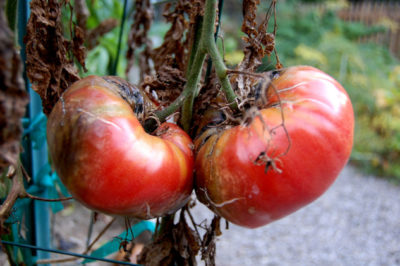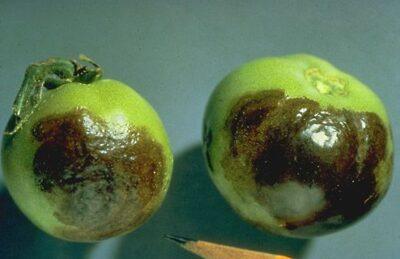 To the home gardener, your garden patch is your nursery and your plants are your babies. I think every gardener that I know grows tomatoes. Whether you eat them fresh or put them into a beautiful homemade sauce, tomatoes are certainly one of the highlights of the growing season.
To the home gardener, your garden patch is your nursery and your plants are your babies. I think every gardener that I know grows tomatoes. Whether you eat them fresh or put them into a beautiful homemade sauce, tomatoes are certainly one of the highlights of the growing season.
But this year in many parts of Canada and the Northern US, something has been attacking and killing tomato plants. It’s called late blight.
Late blight is a disease that affects tomato and potato plants. As it spreads, it will kill the entire plant, and airborne spores can cause it to affect all of the tomato and potato plants in your garden. On windy days (and we’ve had lots of those this year), it can even travel over to your neighbor’s garden or to a nearby farmer.
The pathogen that causes late blight is a fungus-like organism called Phytophthora, and if you have any doubt about its tenacity, it is this organism that was the cause of the Irish potato famine in the 1840s which killed over 1 million people and forced another million to flee their homeland.
Get Delicious, Nutrient-Dense Heirloom Seeds Here!
Because 2014 has been a wet, rainy and cool year for many, it has also been a prolific year for late blight which thrives in soggy weather.
Diagnosing Late Blight
If you’ve never experienced late blight before or you are not sure how to identify it, there are some telltale signs for which you should watch.
Late blight begins with lesions developing on the stems, leaves or even fruit of the plant. These look like dark water-soaked spots and they will grow larger and larger until they cover the entire leaf. Once this happens, the leaf will die but usually remain on the stem.
Sometimes these lesions are accompanied by a fuzzy white substance growing on the underside of the lesion.
Lesions on the stems range from dark brown to black in color while lesions on tomatoes tend to be shiny and olive-colored.
What’s a Gardener to do?
If you’ve determined that you do indeed have late blight, you will not be able to save the plant. The best thing to do is to uproot the plant immediately so that it does not spread to other plants. It is important that these plants do not go in the compost! The plants you pull should be placed in large, sealed plastic bags and allowed to “cook” in the sun for several days. This will kill the pathogen and help to prevent it from spreading back into your garden or into a neighbor’s garden.
Tomatoes and potatoes affected by late blight are still safe to eat, but potatoes should not be stored or used as seed potatoes. If your tomato fruit has been affected, you may still save the seeds, as the disease does not transfer to seeds. However, if you allow the tomato to rot before collecting them, the seeds will die.
An Ounce of Prevention
Sadly, if you are one of the many gardeners that have been affected by late blight this year, there is not much you can do other than salvage any good fruit that you still have.
Want The Best Chemical-Free, All-Natural Insecticide — For Your Garden AND Home?
But if the local weather forecasters start predicting another wet growing season in the future, there are a few things that you can do to help prevent this disease from re-visiting your garden.
- If you had late blight this year, it’s recommended that you deeply till the soil in the late fall. Be sure to remove any vegetation nearby that could harbor the infection.
- Leave enough space between your plants. When plants are crowded together, it will take longer for the leaves to dry off, making them more vulnerable to the pathogen.
- Water around the base of your plants (not the leaves).
- Control your weeds. Some weeds are from the same family as tomatoes and potatoes and can carry and spread the infection.
- Do not plant potatoes that have been harvested from blighted plants. (If you plant grocery store potatoes, you are taking a gamble!)
- Some gardeners will also spray their plants with fungicides in years that they suspect that late blight may be a problem. For the organic gardener, fixed copper is a good choice. Whatever you use, however, it must be applied before the pathogen strikes or it will not work.
The cool, rainy weather that many experienced this year made for prime conditions for this harmful pathogen to propagate and spread, breaking the hearts of many gardeners. Entire crops of tomatoes and potatoes were wiped out seemingly overnight.
But if there is one thing more persistent than the spores that cause late blight, it is the gardeners themselves. Whether we are battling poor weather, critters, weeds, insects or yes, even dreaded late blight, these experiences make us smarter and determined to try (and succeed!) again next year.
How do you prevent late blight in your garden? Share your suggestion in the section below:
 Off The Grid News Better Ideas For Off The Grid Living
Off The Grid News Better Ideas For Off The Grid Living





